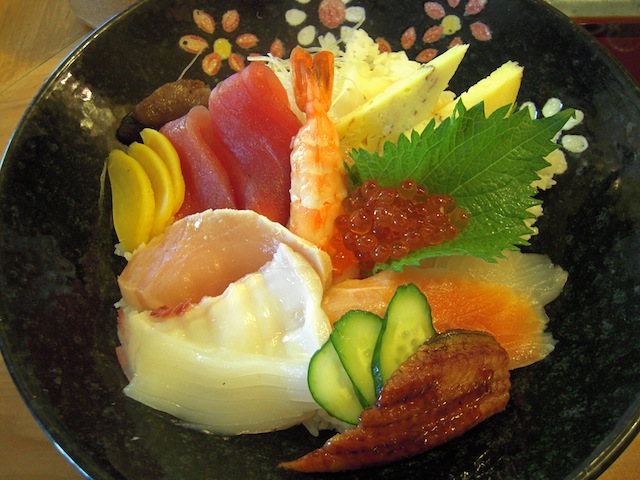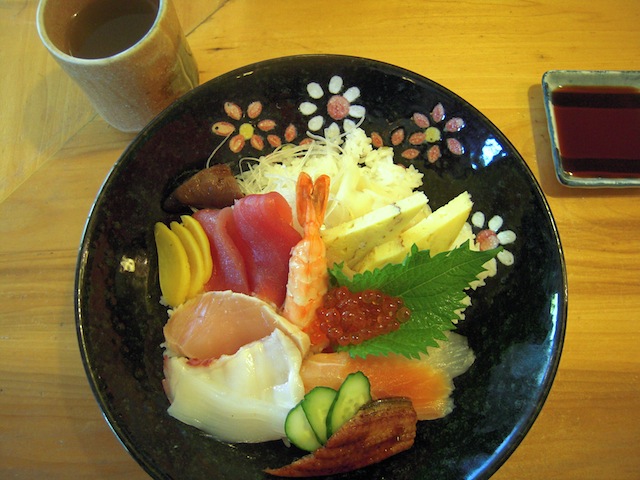
Whenever I go to Sushi Kuni alone for lunch, I always sit at the sushi counter in front of Kuni. It's usually packed with Apple employees and the staff are usually all running around like a bunch of crazed chickens -- so even if I really want to indulge in some nigiri sushi or
makimono, I usually order a chirashi. Why? Cause I know that the last thing Kuni wants to do in the middle of the lunch rush is to make lunch for his hungry daughter, and chirashi is relatively fast and easy to make.
Chirashi is a classic dish of sashimi pieces over a bed of vinegar rice. It comes from the word 散らす (chi-ra-su) meaning "to scatter", as in scattering fish bits all over the place. Kuni says that the origins of chirashi come from wanting to get rid of extra, unattractive pieces of fish, after using the nice parts for proper sashimi platters or for nigiri.
There are two versions of chirashi: the first being the fancy sashimi version you find at sushi restaurants or for take-away at grocery stores around Tokyo. The second is the
bara-chirashi, which is a more humble variation using cooked, not raw, ingredients. Every family has their own version of their bara-chirashi, and my mom always cooked the rice with
renkon (lotus root), carrots and
konnyaku (yam cake). She tops the rice with
tamagoyaki (egg omelette), juliened green beans, and boiled shrimp. MOTO takes his bara-chirashi to the moon and stars, like
this. See, everyone has their own style for bara-chirashi. These days, you will also find sashimi pieces on bara-chirashi, but the fish would be cut more crudely,
in blocks.
Hideko helped me do some research on the origins of chirashi. The bara-chirashi appeared early in the Edo period (1600-1800s) -- a dish that the commoners made for special occasions. Social order and expenditures were strictly monitored by the government during the time, and they would not condone any
zeitaku (extravagance). So when people would make the chirashi, they would hide all the fish pieces and toppings on the bottom of the large plate, and so only the rice would show. When it was time to eat and celebrate (get drunk!), they would simply flip the dish over and dig in. Hilarious!
My mom thinks that the fish they used back then were cooked shrimp and saba (mackerel), which would hold for longer since there was no refrigeration. Kuni thinks they started adding sashimi to this dish when the evolution of sushi came, and they needed to think of a clever way to get rid of the extra, unused pieces of sashimi. Lucky us!
Enjoy chirashi with a cup of tea. Do not overfill the shoyu dish. Just don't do it.

I never think I can finish all the rice under this, but Kuni's sushi rice is really good and before I know it, the fish and rice are gone.
*Sushi Kuni is located at 10211 S. DeAnza Blvd in Cupertino. The Chirashi Deluxe pictured above comes with a cup of miso soup for $20. The more basic version, the Chirashi Regular, is $17.
**Kuni is my father.
 Whenever I go to Sushi Kuni alone for lunch, I always sit at the sushi counter in front of Kuni. It's usually packed with Apple employees and the staff are usually all running around like a bunch of crazed chickens -- so even if I really want to indulge in some nigiri sushi or makimono, I usually order a chirashi. Why? Cause I know that the last thing Kuni wants to do in the middle of the lunch rush is to make lunch for his hungry daughter, and chirashi is relatively fast and easy to make.
Chirashi is a classic dish of sashimi pieces over a bed of vinegar rice. It comes from the word 散らす (chi-ra-su) meaning "to scatter", as in scattering fish bits all over the place. Kuni says that the origins of chirashi come from wanting to get rid of extra, unattractive pieces of fish, after using the nice parts for proper sashimi platters or for nigiri.
There are two versions of chirashi: the first being the fancy sashimi version you find at sushi restaurants or for take-away at grocery stores around Tokyo. The second is the bara-chirashi, which is a more humble variation using cooked, not raw, ingredients. Every family has their own version of their bara-chirashi, and my mom always cooked the rice with renkon (lotus root), carrots and konnyaku (yam cake). She tops the rice with tamagoyaki (egg omelette), juliened green beans, and boiled shrimp. MOTO takes his bara-chirashi to the moon and stars, like this. See, everyone has their own style for bara-chirashi. These days, you will also find sashimi pieces on bara-chirashi, but the fish would be cut more crudely, in blocks.
Hideko helped me do some research on the origins of chirashi. The bara-chirashi appeared early in the Edo period (1600-1800s) -- a dish that the commoners made for special occasions. Social order and expenditures were strictly monitored by the government during the time, and they would not condone any zeitaku (extravagance). So when people would make the chirashi, they would hide all the fish pieces and toppings on the bottom of the large plate, and so only the rice would show. When it was time to eat and celebrate (get drunk!), they would simply flip the dish over and dig in. Hilarious!
My mom thinks that the fish they used back then were cooked shrimp and saba (mackerel), which would hold for longer since there was no refrigeration. Kuni thinks they started adding sashimi to this dish when the evolution of sushi came, and they needed to think of a clever way to get rid of the extra, unused pieces of sashimi. Lucky us!
Enjoy chirashi with a cup of tea. Do not overfill the shoyu dish. Just don't do it.
Whenever I go to Sushi Kuni alone for lunch, I always sit at the sushi counter in front of Kuni. It's usually packed with Apple employees and the staff are usually all running around like a bunch of crazed chickens -- so even if I really want to indulge in some nigiri sushi or makimono, I usually order a chirashi. Why? Cause I know that the last thing Kuni wants to do in the middle of the lunch rush is to make lunch for his hungry daughter, and chirashi is relatively fast and easy to make.
Chirashi is a classic dish of sashimi pieces over a bed of vinegar rice. It comes from the word 散らす (chi-ra-su) meaning "to scatter", as in scattering fish bits all over the place. Kuni says that the origins of chirashi come from wanting to get rid of extra, unattractive pieces of fish, after using the nice parts for proper sashimi platters or for nigiri.
There are two versions of chirashi: the first being the fancy sashimi version you find at sushi restaurants or for take-away at grocery stores around Tokyo. The second is the bara-chirashi, which is a more humble variation using cooked, not raw, ingredients. Every family has their own version of their bara-chirashi, and my mom always cooked the rice with renkon (lotus root), carrots and konnyaku (yam cake). She tops the rice with tamagoyaki (egg omelette), juliened green beans, and boiled shrimp. MOTO takes his bara-chirashi to the moon and stars, like this. See, everyone has their own style for bara-chirashi. These days, you will also find sashimi pieces on bara-chirashi, but the fish would be cut more crudely, in blocks.
Hideko helped me do some research on the origins of chirashi. The bara-chirashi appeared early in the Edo period (1600-1800s) -- a dish that the commoners made for special occasions. Social order and expenditures were strictly monitored by the government during the time, and they would not condone any zeitaku (extravagance). So when people would make the chirashi, they would hide all the fish pieces and toppings on the bottom of the large plate, and so only the rice would show. When it was time to eat and celebrate (get drunk!), they would simply flip the dish over and dig in. Hilarious!
My mom thinks that the fish they used back then were cooked shrimp and saba (mackerel), which would hold for longer since there was no refrigeration. Kuni thinks they started adding sashimi to this dish when the evolution of sushi came, and they needed to think of a clever way to get rid of the extra, unused pieces of sashimi. Lucky us!
Enjoy chirashi with a cup of tea. Do not overfill the shoyu dish. Just don't do it.
 I never think I can finish all the rice under this, but Kuni's sushi rice is really good and before I know it, the fish and rice are gone.
*Sushi Kuni is located at 10211 S. DeAnza Blvd in Cupertino. The Chirashi Deluxe pictured above comes with a cup of miso soup for $20. The more basic version, the Chirashi Regular, is $17.
**Kuni is my father.
I never think I can finish all the rice under this, but Kuni's sushi rice is really good and before I know it, the fish and rice are gone.
*Sushi Kuni is located at 10211 S. DeAnza Blvd in Cupertino. The Chirashi Deluxe pictured above comes with a cup of miso soup for $20. The more basic version, the Chirashi Regular, is $17.
**Kuni is my father.




Comments (2)
This looks so good! Totally zeitaku! The variations for chirashi are interesting. I always have the chirashi at the sushi place at Narita before boarding the plane. I also used to have chirashi for lunch often when I worked two blocks away from Tsukiji. As you note, everyone has their own version, and to this day, I still think my mom’s is #1.
Hi Kayoko – I love this series. Kepp ’em coming!